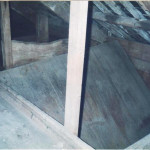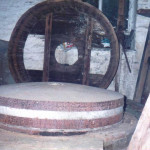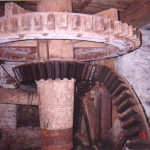.
Ridgegrove Mills is really the grain mills, the part used as a woollen factory and then the foundry, etc is beside the old mill. Around 1800 Ridgegrove Mills was in the possession of Mr William Thorley John Braund, miller and farmer, who entered into an agreement to share his mill stream with Mr John Langdon who desired to build himself a woollen mill alongside the grist mill, using the stream to power both mills for making serges for the East India Company. This became redundant around 1848 due to the larger factories in the north of England which had better water for power and washing and was also near the new coal mines, so enabling steam to be used.
Mr Langdon erected his works with a sixteen feet diameter, hip-shot water wheel to drive his machinery, the exhausted water from the wheel being returned into the grist mill tail.
Both grist and woollen mills were offered for sale in November 1803, and then again in 1814 with the following description:
“Sale. Desirable and Extensive Yarn and Worsted manufactury, Grist Mills, Dwelling House, Garden, and Meadow Land, near Launceston. To be sold at Auction at the Exeter Inn, Launceston, on Tuesday 6th. December.” The Notice goes on to describe the whereabouts and form of the goods. “….Each Factory is Four Storeys high, built of the very best materials, and in every respect adequate to the carrying on a most extensive Business, being extremely spacious and having an incessant Stream of Water to work with.
“The Machinery consists of: Carding-Machines, Spinning-Jennys, Scribblers, Billys, Breakers, Worsted-Machines, Drawing-Frames, Warping-Framer, and Skainers, …etc.”
Under ‘Lot Two’ is described – “A Well-Accustomed Grist Mill, with Two Pair of Mill-Stones, in full work, (situate near the First Lot) together with Dwelling House… Etc”.
The ownership of Knowles and Ridgegrove mills was in the hands of Mr William Harvey from 29 April, 1820. The newspaper ‘The West Briton’ carried an advertisement on 28 March 1826 to sell, under a Commission of Bankrupt awarded and issued against Mr William Harvey of Launceston, Banker, Ridgegrove Mills and giving a description of all the premises connected with it.
Ridgegrove mill is next offered for sale on the 25th of May, 1826 and is described again as having two pair of mill-stones and being sold with the ‘newly erected woollen mills alongside’.
Pigot & Co’s Directory for 1830 gives the miller as Mr Bailey, and it was during his ownership that the grist mills were updated and refurbished with a second water-wheel and additional machinery fitted inside the mill. The new wheels were of cast-iron shrouds; woodwork made up the baseboards and buckets. This was probably the time that the grain cleaner and flour dresser were installed and possibly the sack-hoist also put in. The water-wheels were cast by T. Coombe, Ironfounder, Launceston.
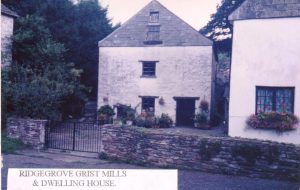
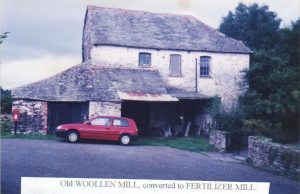
A further sales notice in the ‘West Briton’ newspaper dated 6th June, 1834, describes the woollen mills as in the occupation of Mr Thomas Hague, of a well-known Launceston family, and states the grist mill now has Three sets of mill-stones.
The woollen mills, when in full production, employed up to 200 men, women and children, producing serges for the East India Company, as well as other materials.
The woollen mills went out of production around 1850 and part was converted to a bone-crushing and fertilizer plant which, on 14 January 1861, was offered for sale by Mr Henry Essary, described in the Post Office Directory as ‘Farmer & Merchant of Bamham’. In the ‘East Cornwall Times’ dated January, 19th, 1861, appears a sales notice for Bone Mills and the bone mills business, which had been carried on at Ridgegrove by Mr. Henry Essary, who wished to sell it as a going concern so that he could concentrate on other business interests, showing that the woollen trade had been long gone by this time. This business appears to have been bought by Messrs. J & H Hender & Co. Bone Millers & Fertilizer Manufacturers, as the 1878 Directory names them.
Following the death of Mr William Wentworth Fitzwilliam Dick, of County Wicklow, owner-occupier of Werrington Manor, the whole of the ancient manor was offered for sale by the appointed agents, in many Lots and Portions, some of which were farms, houses, schools and other lands and dwellings etc., in 1871.
Also included in the sales were: the Lordship of the Manor of ‘Launceston Lands and Borough of Newport,’ with Court Leet, and the Advowsons of Werrington and St Mary Magdalene.
LOT numbers 728 and 730, were ‘The Water Corn Mill, known as Ridgegrove Mill, substantially built of Stone and Slate, in 3 Floors, driven by 2 Water-wheels, each about 13 feet in diameter, 2 pair of Stones and a portion of the Driving-gear (another pair of Stones and the remainder of the Gear belong to the Tenant). The Mill-house, containing 2 Sitting-rooms, Kitchen and Dairy, and 4 Bed-rooms, Stone and Slate, together with a cart Shed, Cattle Shed and Piggeries, Stone and Slate, and Chaise-house. Quantity 1 rood 30 perches
Of later years the building was used as an agricultural machinery and animal shelter, but in 1999 it was bought and converted to a dwelling. A 16ft. water wheel is still in position on the side of the building. Inside is a ‘clasp-arm wheel’, said by a well-known mills expert to be ‘a rare example of an early 19th Century lineshaft drive. (This wheel is now preserved within the dwelling).
The weights were found beneath the dirt floor during excavations to determine the quality of foundations before the old mill could be altered to make a cottage. The water-wheel has also been renovated but is still without water to power it in 2003.
Mr Box bought part of the old woollen buildings for his foundry and this is probably also the part used by Mr Braund. The Jones family bought the grain mill around 1871/2; they were millers there from the early 1840s and were there until 1954, when it passed to Mr Reuben Gabriel, then to his son John, who still owns most of the land surrounding it.

Visits: 252





